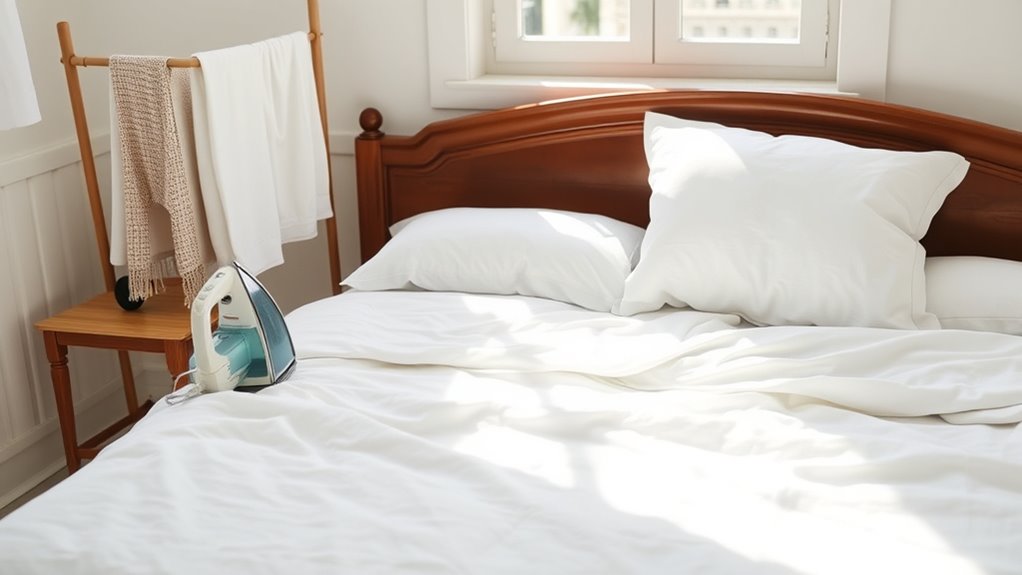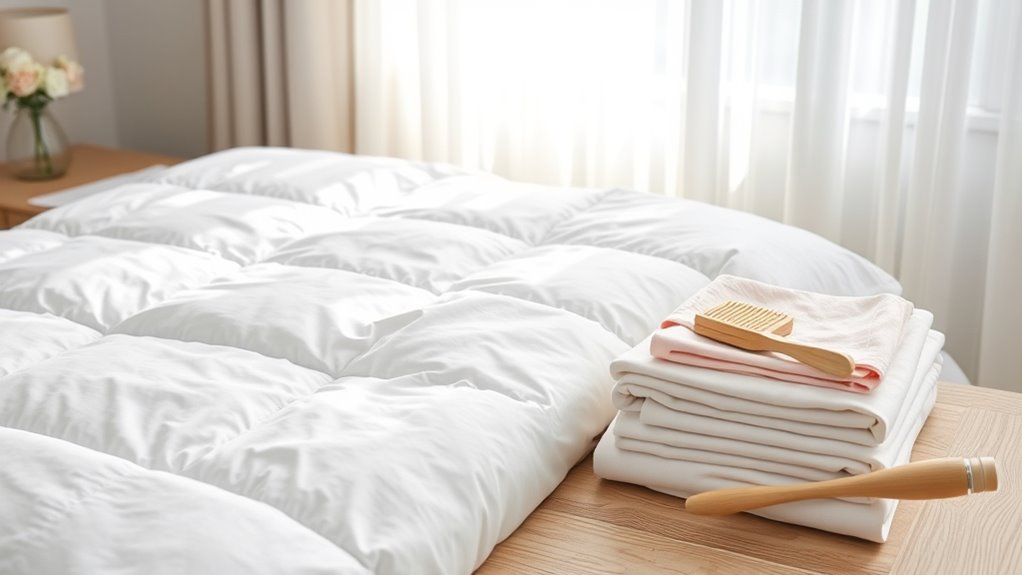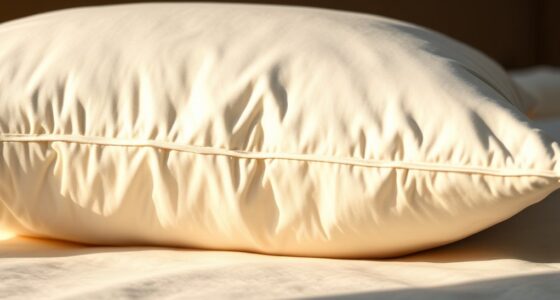To wash and care for your bedding properly, start by sorting by color and fabric, treating stains beforehand. Use gentle or appropriate cycles with the right detergent, and dry on low or air dry to prevent damage. Iron slightly damp on medium heat, and deep clean monthly with hot water to eliminate dust mites and allergens. To keep everything fresh and allergen-free, follow these tips carefully—you’ll uncover more useful advice as you continue.
Key Takeaways
- Separate bedding by color and fabric type before washing to prevent bleeding and damage.
- Use appropriate detergents and gentle cycles for delicate fabrics, and regular cycles for cotton and linen.
- Wash bedding weekly in hot water (at least 130°F) to reduce allergens and bacteria effectively.
- Tumble dry on low heat or air dry in shaded areas to preserve fabric integrity and prevent sun damage.
- Regularly treat stains, deep clean monthly, and use allergen barriers to maintain freshness and hygiene.
Sorting and Pre-Treating Your Bedding

Before washing your bedding, start by sorting it into separate loads based on color and fabric type. This helps prevent color bleeding and fabric damage. Check for stains and treat them with stain removers before washing. Apply stain removers directly to spots and let them sit for a few minutes to loosen dirt. If you want softer bedding, consider adding fabric softeners during the wash cycle, but avoid using too much, as it can build up over time. Separate delicate fabrics like silk or satin from sturdier materials such as cotton or linen to prevent damage. Proper sorting and pre-treatment ensure your bedding stays fresh, vibrant, and in good condition longer. Taking these steps makes your laundry more effective and preserves your bedding’s quality. Additionally, understanding the importance of contrast ratio can help you select the right home projector for optimal image quality.
Choosing the Right Detergent and Wash Cycle

Selecting the appropriate detergent and wash cycle is essential to keep your bedding clean and in good condition. Use a gentle cycle for delicate fabrics like silk or linen, and a regular cycle for cotton sheets. Choose a detergent that suits your needs; some contain fabric softeners for extra comfort, while others include stain removers for tough spots.
| Fabric Type | Recommended Detergent | Best Wash Cycle |
|---|---|---|
| Cotton | Regular or stain remover | Normal |
| Silk/Linen | Gentle, fragrance-free | Delicate |
| Microfiber | Softener-enhanced | Gentle or delicate |
Matching your detergent type and cycle ensures your bedding stays fresh, soft, and stain-free longer.
Drying and Ironing Tips for Linen Longevity

To preserve the crispness and durability of your linen bedding, proper drying and ironing techniques are essential. After washing, tumble dry on a low heat setting or hang your linen to air dry in a shaded area to prevent sun damage. Avoid over-drying, which can weaken fibers. For extra softness, use fabric softeners sparingly, as they can coat fibers and reduce breathability. When ironing, do so while the fabric is slightly damp to make wrinkles easier to remove and to prevent scorching. Use a medium to high heat setting and iron on the reverse side to protect the fabric’s surface. For stubborn stains, always handle stain removal before drying, but avoid ironing directly over stains to prevent setting them permanently. Incorporating proper fabric care techniques can further extend the lifespan of your bedding.
Regular Deep Cleaning and Maintenance Practices

Regular deep cleaning is essential to keep your bedding fresh, hygienic, and free of allergens. To maintain this, follow these practices:
- Use fabric softeners sparingly to keep bedding soft without buildup.
- Perform regular stain removal by pre-treating spots with a gentle solution before washing.
- Deep clean your bedding at least once a month with hot water to eliminate dust mites and bacteria.
- Consider using vetted home theatre projectors to ensure your space remains comfortable and hygienic during movie nights.
Tips for Maintaining Freshness and Preventing Allergens

Keeping your bedding fresh and free from allergens goes beyond just regular deep cleaning. To prevent allergen buildup, use allergen barriers like dust-mite-proof covers on pillows and mattresses. Wash bedding weekly in hot water, at least 130°F, to eliminate dust mites, pet dander, and pollen. When drying, add fabric softeners to keep fabrics soft and reduce static, which can trap allergens. Avoid overloading your washer to ensure thorough cleaning. Using hypoallergenic detergents also helps reduce chemical residues that can trigger allergies. Regularly vacuum your mattress and pillows, and air out bedding whenever possible. Incorporating air purifier features, such as HEPA filtration, can further improve indoor air quality by capturing airborne allergens. These simple steps, combined with proper washing techniques, help maintain freshness and create a healthier sleeping environment.
Frequently Asked Questions
How Often Should I Replace My Bedding for Optimal Cleanliness?
You should replace your bedding regularly to maintain ideal cleanliness and extend its lifespan. Typically, pillowcases and sheets need replacement every 1-2 years, while comforters and mattress protectors might last 5-10 years, depending on wear. Monitoring the bedding’s condition helps you determine the right replacement frequency. Regularly updating your bedding not only keeps your sleeping environment fresh but also supports your overall health and comfort.
Can I Wash Bedding With Other Household Items Safely?
Imagine you’re a knight in a castle, ensuring laundry safety and household compatibility. You can wash bedding with other household items if they share similar colors and fabric types. Avoid mixing delicate fabrics or items with heavy dirt or stains to prevent damage. Always check care labels and separate whites from colors. This way, you protect your bedding and household items, maintaining cleanliness and extending their lifespan efficiently.
Are There Specific Storage Tips to Keep Bedding Fresh Between Washes?
To keep your bedding fresh between washes, focus on proper bedding storage and freshness preservation. Store your bedding in a cool, dry, and well-ventilated space, preferably in breathable cotton or linen storage bags. Avoid plastic containers, which trap moisture and cause mustiness. Regularly air out your bedding, especially during warmer months, to maintain freshness. Using natural deodorizers like lavender sachets can also help keep your bedding smelling clean.
How Do I Remove Stubborn Stains From Bedding Effectively?
Did you know that over 60% of people struggle with stubborn stains? For effective stain removal, act quickly and avoid rubbing. Use a fabric treatment like a stain remover or a mix of baking soda and water directly on the stain. Let it sit for a few minutes before washing. This approach helps break down the stain, making it easier to remove and keeping your bedding fresh and clean.
What Are Eco-Friendly Alternatives to Traditional Bedding Detergents?
If you’re looking for eco-friendly alternatives to traditional bedding detergents, consider plant-based detergents. They effectively clean without harmful chemicals and are gentle on your skin and the environment. You can also use natural fabric softeners, like white vinegar or essential oils, to keep your bedding soft and fresh. These options help reduce your ecological footprint while maintaining clean, comfortable bedding.
Conclusion
By following these simple bedding care tips, you’ll keep your bed fresh and inviting. Did you know that dust mites thrive in unwashed bedding, affecting 75% of allergy sufferers? Regular washing not only keeps allergens at bay but also extends your bedding’s lifespan. So, make this routine a habit, and enjoy a cleaner, healthier sleeping environment every night. Your bed will thank you for it, and you’ll sleep better knowing you’re taking good care of your space.









